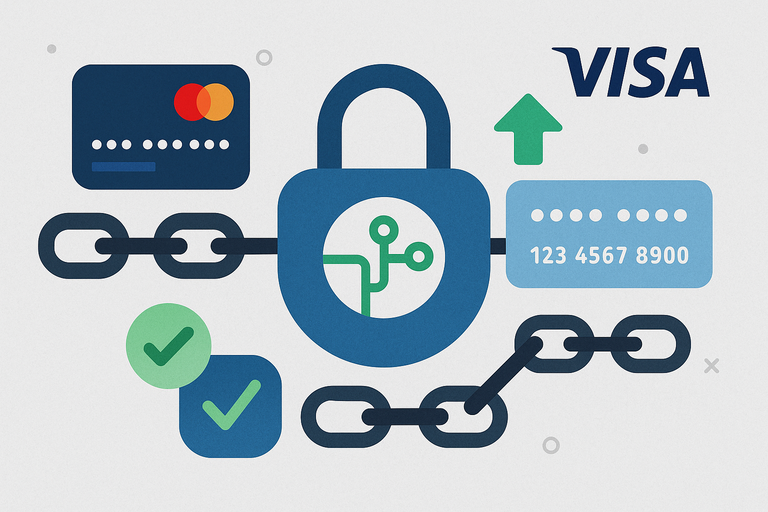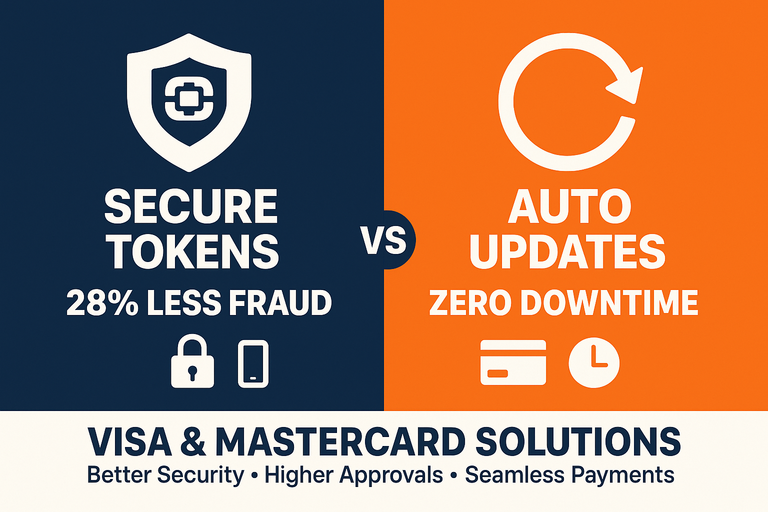Network Tokenization vs Account Updater in Card Acquiring
A detailed guide comparing Visa and Mastercard’s network tokenization and account updater services. Learn how each works, why both matter for fraud prevention and payment continuity, and when merchants need one or both solutions to optimize authorization rates and reduce declines.

Understanding Network Tokenization vs. Account Updater in Card Acquiring: Visa & Mastercard Deep Dive
For payments professionals and fintech teams, two services often come up when discussing card-on-file security and transaction continuity: network tokenization and account updater services. While both are provided by Visa and Mastercard globally, they serve distinct purposes with different technical mechanisms. Here is a clear breakdown of each, focusing on operational details, business implications, and how they work together.
What Is Network Tokenization?
Purpose: Replaces a card's primary account number (PAN) with a network-issued token. These tokens can be transacted exactly like a real card number but are locked down with additional security controls.
How It Works:
- Token Provisioning: A merchant or wallet requests a token from Visa Token Service (VTS) (https://usa.visa.com/partner-with-us/payment-technology/visa-token-service.html) or Mastercard MDES (https://www.mastercard.com/global/en/business/overview/digital-merchant-solutions/mdes.html). The token looks like a 16-digit card number but is linked to the real PAN in the network's token vault.
- Domain Controls: Tokens are restricted to a specific domain - for example, only usable by a certain merchant or on a certain device.
- Cryptograms: Each transaction requires a dynamic, one-time cryptogram that ties the token to the transaction. This makes intercepted tokens useless for fraudsters.
- Lifecycle Management: When a card is reissued or updated, the token vault is automatically updated. Merchants don’t need to request new credentials - the token stays the same and remains valid.
Business Benefits:
- Reduces card-not-present (CNP) fraud by up to 28% (source: Visa Token Service Overview).
- Increases authorization approval rates by 2-3% on average.
- Reduces PCI DSS scope for merchants storing only tokens instead of PANs.
- Eligible for interchange incentives in some regions.
What Is Account Updater?
Purpose: Keeps merchants’ card-on-file data current by updating PANs and expiration dates when a card is replaced.
How It Works:
- Pull Model: Merchants or their processors send batch files or API requests to Visa Account Updater (VAU) (https://usa.visa.com/partner-with-us/payment-technology/account-updater.html) or Mastercard Automatic Billing Updater (ABU) (https://www.mastercard.us/en-us/business/overview/small-business/payment-processing/automatic-billing-updater.html) to check for updates.
- Push Model: The networks proactively send updates to subscribed merchants/acquirers as soon as issuers report them.
- Use Case: Critical for subscription billing, recurring payments, and any stored card scenario without full network tokenization.
Business Benefits:
- Reduces declines from outdated card info.
- Maintains recurring revenue streams.
- Preserves customer relationships by avoiding service disruptions.
Do You Need Both Services?
If you are fully using network tokens for all card-on-file data and all issuers support token lifecycle management, account updater is redundant for those tokens.
However, in the real world:
- Not all issuers participate in token programs yet.
- Some merchants still store raw PANs alongside tokens.
For these reasons, most acquirers and merchants deploy both services together to cover all scenarios.
Key Differences: Quick Comparison Table
FeatureNetwork TokenizationAccount UpdaterFunctionReplaces PAN with a secure tokenUpdates stored PAN when card changesSecurityHigh (domain controls + cryptograms)Standard PAN securityFraud ImpactReduces CNP fraud significantlyIndirect (avoids declines, not fraud)Authorization ImpactImproves approval ratesAvoids declines from invalid credentialsPCI Scope ImpactReduces merchant PCI DSS scopeNo changeLifecycle UpdatesBuilt-in, automatic via token vaultVia separate process (pull or push)Use CaseMobile wallets, e-commerce, digital paymentsRecurring billing, subscription services
Full Comparative Summary
- Core Function: Tokenization replaces PAN with a token; account updater keeps PANs current.
- Security: Tokenization adds domain restrictions and dynamic cryptograms; account updater relies on secure channels but still deals with real PANs.
- Fraud Reduction: Tokenization is preventative; account updater avoids service disruptions but doesn’t prevent fraud directly.
- Authorization Rates: Both improve them, tokenization through security and up-to-date tokens, updater through updated PANs.
- PCI Compliance: Tokenization reduces scope; updater does not.
- Use Cases: Tokenization for digital-first payments; updater for subscriptions and legacy card-on-file systems.
- Costs: Tokenization may reduce processing fees due to fraud incentives; account updater typically incurs small per-update fees.
Final Thoughts
For payments teams and fintech founders, understanding where network tokenization ends and account updater begins is key to optimizing authorization rates, reducing fraud, and maintaining customer retention. Visa and Mastercard have engineered both systems to complement each other, but as network token adoption grows, reliance on account updater services may gradually diminish.
Both are essential tools in building a future-proof card acquiring strategy.
For those interested in the technical details, read our deep dive here.
Sources:
- Visa Token Service (https://usa.visa.com/partner-with-us/payment-technology/visa-token-service.html)
- Mastercard MDES (https://www.mastercard.com/global/en/business/overview/digital-merchant-solutions/mdes.html)
- Visa Account Updater (https://usa.visa.com/partner-with-us/payment-technology/account-updater.html)
- Mastercard Automatic Billing Updater (https://www.mastercard.us/en-us/business/overview/small-business/payment-processing/automatic-billing-updater.html)
- EMVCo Tokenization Framework (https://www.emvco.com/emv-technologies/payment-tokenisation/)


